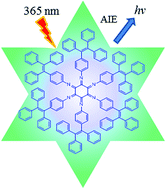Aggregation-induced emission of a star-shape luminogen based on cyclohexanehexone substituted with AIE active tetraphenylethene functionality†
Abstract
We describe a rigid star-shaped luminogen (HTCA) of cyclohexanehexone bearing six tetraphenylethene moieties, which exhibited strong aggregation-induced emission (AIE) characteristics. The twisting amplitude and steric hindrance of the TPE units were found to play a crucial role in their aggregated nano- to micro-structures. Interestingly, HTCA exhibits reversible piezofluorochromic behaviour through grinding which is reversed by treatment with solvents resulting in a cycle that can be repeated several times.


 Please wait while we load your content...
Please wait while we load your content...